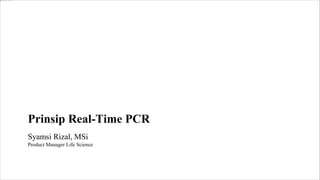
RT-PCR.pptx
- 1. Prinsip Real-Time PCR Syamsi Rizal, MSi Product Manager Life Science
- 2. PCR and RT-PCR PCR, or the Polymerase Chain Reaction, is a process for the amplification of specific fragments of DNA tell us what Real-Time PCR a specialized technique that allows a PCR reaction to be visualized “in real time” as the reaction progresses tell us how much As we will see, Real-Time PCR allows us to measure minute amounts of DNA sequences in a sample!
- 3. Definition Real-time PCR is the continuous collection of fluorescent signal from one or more polymerase chain reactions over a range of cycles. Quantitative real-time PCR is the conversion of the fluorescent signals fromeach reaction into a numerical value for each sample
- 4. PCR Amplification of DNA In theory, product accumulation is proportional to 2n, where n is the number of amplification cycle repeats.
- 5. PCR, Theory vs Reality In Theory, PCR reactions amplify exponentially, doubling every cycle and grow forever. In Reality, The reactant for polymeration is limited. Threshold Cycle • threshold cycle or the CT value is the cycle at which a significant increase in DRn is first detected. • it is the parameter used for quantitation * CT value of 40 or more means no amplification and cannot be included in the calculations
- 6. In real-time PCR reactions, fluorescent molecules are used to monitor the reaction while amplification is taking place Dual hybridization probes (FRET), Eclipse probes, Amplifluor assays, Scorpions PCR primers, LUX PCR primers, QZyme PCR primers
- 7. How do we detect and measure DNA? 1. Non-specific fluorescent dyes: - intercalation with any dsDNA - SYBR green, EVAGREEN 2. Sequence specific primers & DNA probes: - oligonucleotides labeled with fluorescent reporter (a) Hydrolisis probe: TaqMan, Molecular Beacon, Scorpion (b) Hybridizing probe: FRET
- 8. TaqMan probe-based assays are widely used in quantitative PCR in research and medical laboratories: • Gene expression assays • Pharmacogenomics • Human Leukocyte Antigen (HLA) genotyping • Determination of viral load in clinical specimens (HIV, Hepatitis) • Bacterial Identification assays • DNA quantification • SNP genotyping • Verification of microarray results
- 9. LAMPUNG 0% 10% 20% 30% 40% 50% 60% 70% 80% Taqman Probes Molecular Beacon FRET Probes LUX Fluorogenic Primer MGB Eclipse Probes Other Scorpion Probes Molecular Probe